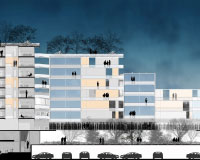Communicate the results of an architectural research
How to design a digital scientific article in the architectural field
DOI:
https://doi.org/10.18861/ania.2021.11.1.3100Keywords:
scientific paper, digital resources, architecture, research, architectural communicationAbstract
The scientific paper is the preferred form in which advances in any field of science are communicated. The publishing of scientific journals has undergone a digital transformation, even in areas such as architecture, where this process has paradoxically been slow. However, papers that make in architectural journals are still written and published as if they were still in a printed format, the conventional system inaugurated by Gutenberg. Such traditional publications are limited into two-dimensional format, which does not recognize the way of communicating ideas in architecture. This article explores the possibilities of this new digital format, closer to the architectural gesture, which, while valuing traditional forms such as sketches, plans or photographs, incorporates new possibilities offered by digital magazines such as digital models and evolving infographics. These types of projective representations multiply the communication possibilities of researchers and creators. As a result, the contemporary paper can and should be representative of the innovation that underlies its existence. Its content is a vivid reflection of the natural evolution of architectural, urban or landscape research. This makes it necessary for the scientific paper to include new types of dynamic formats. This article presents some of these formats and methods for communicating the results of architectural research today: hypertexts, embedded resources, geo-referenced images, 3D models and linked bibliography, among others. This article is in turn an invitation to the authors to enrich their practices with the resources of visual, graphic and textual language.
Downloads
References
Allen, S. (1998). Diagrams matter. ANY: Architecture New York, 23, 16-19. Recuperado de http://www.jstor.org/stable/41856094
Appleton, K. & Lovett, A. (2005) GIS-based visualisation of development proposals: Reactions from planning and related professionals. Computers, Environment and Urban Systems, 29(3), 321-339. https://doi.org/10.1016/j.compenvurbsys.2004.05.005
de Brito, M.(2001). Présentation de la bibliothèque électronique SciELO et de ses DTD. Expertise de ressources pour l'édition de revues numériques. Recuperado de http://revues.enssib.fr/pdf/Dtd-scielo.pdf
Montaner, J. (2014). Del diagrama a las experiencias, hacia una arquitectura de la acción. Barcelona, España: Gustavo Gili.
See how the vaccine rollout is going in your county and state (31 de marzo de 2021). The New York Times. Recuperado de: https://www.nytimes.com/interactive/2020/us/covid-19-vaccine-doses.html
Packer, A., Prat, A., Luccisano, A., Montanari, F., Santos, S. & Menghini, R. (2006) El modelo SciELO de publicación científica de calidad en acceso abierto. En D. Babini y J. Fraga (Eds.). Edición electrónica, bibliotecas virtuales y portales para las ciencias sociales en América Latina y El Caribe (pp. 191-208). Buenos Aires, Argentina: CLACSO. http://biblioteca.clacso.edu.ar/clacso/se/20100528035351/10Parcker.pdf
Perkel, J. (2018) Data visualization tools drive interactivity and reproducibility in online publishing. Nature, 554, 133-134. https://doi.org/10.1038/d41586-018-01322-9
Ponzini, D., Nastasi, M. (2011). Starchitecture: Scenes, actors and spectacles in contemporary cities. Turin, Italia: Allemandi.
Rodríguez, E. (2018). Diagramanía. Anales de Investigación en Arquitectura, 7, 25-42. https://doi.org/10.18861/ania.2017.7.0.2847
Somers, J. (5 de abril de 2018). The scientific paper is obsolete. The Atlantic. Recuperado de
https://www.theatlantic.com/science/archive/2018/04/the-scientific-paper-is-obsolete/556676/
Sopinka, N., Coristine, L., DeRosa, M., Rochman, C., Owens, B. & Cooke, S. (2019). Envisioning the scientific paper of the future. Facets,5(1), 1-16. https://doi.org/10.1139/facets-2019-0012
Ynnerman, A., Löwgren, J. & Tibell, L. (2018) Exploranation: A new science communication paradigm. IEEE Computer Graphics and Applications, 38(3), 13-20. https://doi.org/10.1109/MCG.2018.032421649
Dataset:
Castro-Marcucci, Andrea; Belandria-Gutiérrez, Daniel (2021), “Comunicar los resultados de la investigación arquitectónica. Cómo diseñar un artículo científico digital en el ámbito arquitectónico”, Mendeley Data, V2, doi: 10.17632/4gdcpp82bv.2

Published
Versions
- 2021-05-10 (4)
- 2021-05-06 (3)
- 2021-05-06 (2)
- 2021-05-06 (1)
How to Cite
Issue
Section
License
Copyright (c) 2020 Andrea Castro Marcucci, Daniel Belandria

This work is licensed under a Creative Commons Attribution 4.0 International License.
The journal and its contents are licensed under the Creative Commons - Attribution 4.0 International License (CC BY 4.0). It is possible to copy, communicate and publicly distribute its content as long as the individual authors and the name of this publication are cited, as well as the publishing institution (Universidad ORT Uruguay).

